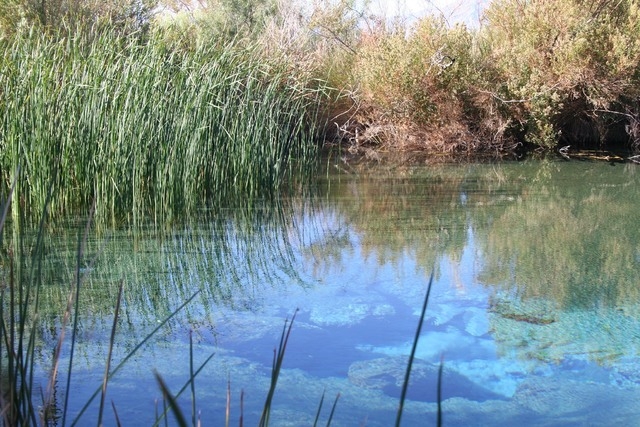Historic Ash Meadows a great nature day trip
A great, short getaway is Ash Meadows National Wildlife Refuge, less than a 45-minute drive from Pahrump.
Lying in Nevada near the California state line, it’s close enough to enjoy thoroughly in a single day. Now is an especially good time to go if you enjoy birdwatching or counting how many different kinds you can see; for the spring migratory season is upon us. More than 275 bird species have been recorded in the refuge.
Some species you might see this time of year include red-winged blackbird, verdin, horned lark, killdeer, white-faced Ibis, American bittern, great blue heron and a large variety of waterfowl.
Encompassing about 24,000 acres, this is not one of our country’s bigger sanctuaries, yet it’s the largest oasis in the Mojave Desert. Its seven major springs and accompanying wetlands support 26 endemic life forms — creatures found nowhere else in nature!
One of rarest, the Devil’s Hole pupfish, occurs naturally only in a single spring with a surface area hardly bigger than a bathtub, and clings to existence so perilously that this spring is closed to all but scientific visits. However, there are three other native fish species in the park. The easiest to spot is the Amargosa pupfish and can be seen at the King’s Pool along the Point of Rocks Trail. The trail is a quarter-mile loop of boardwalk that leads you to their favorite hangout, the crystal-clear waters of a natural pool. They’re all tiny creatures, but the males are turquoise-colored and a little bigger than the green females.
Pupfish also live, but are harder to spot, in Crystal and Longstreet springs. The Crystal Springs boardwalk trail starts near the visitor center, and takes you about 0.7 miles round trip. There are interpretive signs and resting benches along the way. This spring produces about 2,800 gallons of water per minute. This area is also where desert bighorn sheep are most likely to be seen.
The Longstreet Spring is a beautiful blue natural artesian well, about the size of a small man-made backyard pool. It’s also known as “the boiling spring” because the water flows upward from it so strongly that the white sands on its bottom churn in constant motion. This place is not only a natural wonder but a historic site, for next to the spring stands a charming cabin built by frontiersman Jack Longstreet in 1895 and restored in 2005.
Longstreet was born about 1830, is said to have served in the Confederate army, and showed up in Nevada by the 1880s. A saloon operator and small rancher, he became an advocate for the oppressed Southern Paiute people and was instrumental in arranging the replacement of at least one incompetent or corrupt Indian agent. Once he led a mob of Indian laborers against a mine superintendent who refused to pay them fairly. They yanked him from his bed, marched him around his yard naked while the laborers “switched” him with twigs, inspiring a change of heart.
Longstreet had to flee to avoid prosecution for his part in this extralegal proceeding, but he was an old hand at such flights. His long hair covered an ear cropped short for cattle rustling, and his .44 Colt pistol had more than one notch on its grip. In fact, it is said Longstreet settled at the spring that now bears his name partly because it offered the means to withstand a siege by a posse or other unwelcome visitors. Besides the big water supply at the front door, the cabin had an internal one. Its back wall is dug into a spring mound, whose cooling waters also served Longstreet as a primitive refrigerator. And he built the walls of the cabin out of bulletproof stone. A bullet bearing Longstreet’s name actually did find its fatal mark, but not until 1928, and Longstreet himself discharged it, probably by accident.
The brand new refuge visitor center is open Monday through Wednesday 9 a.m. to 2:30 p.m., and Thursday through Sunday 9 a.m. to 4:30 p.m. Contact at 775-372-5435 or through www.fws.gov/refuge/ash_meadows for more details.
Deborah Wall is the author of “Base Camp Las Vegas, Hiking the Southwestern States,” “Great Hikes, A Cerca Country Guide,” and co-author of “Access For All, Touring the Southwest with Limited Mobility.” Wall can be reached at Deborabus@aol.com.
















